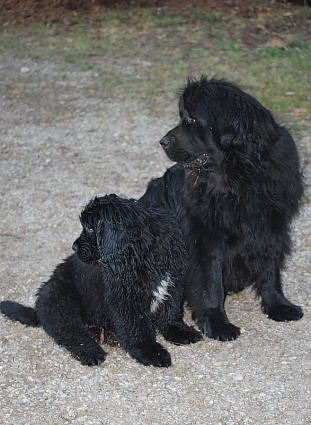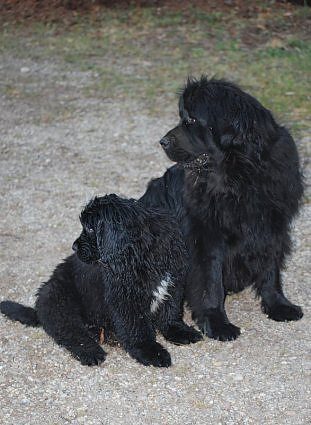

Why Are Dogs A Mirror?
This picture illustrates two dogs hard at "work" being each other’s mirror. The phenomenon isn’t unique to dogs of course and it’s hardly a matter of work because mirroring is the nature of every emotional being. Horse and rider, are a mirrored pair, male reflects female and vice versa, the predator mirrors the prey it hunts, there is Yin and there is Yang, and when you think about it, training a dog to heel is teaching a dog to mirror his handlers’ movements. Furthermore every breed of dog in personality and behavior is a reflection of the fight/flight characteristics of the prey it was selected to hunt. The new discipline of epigenetics (above-the-genes) reveals how genes are activated by environmental triggers. In other words, genes are not self-contained units of information, but need to be catalyzed in a sequential order so that in the final analysis an animal’s phenotype reflects its surroundings, most especially, the emotional climate it finds itself in.
My point is that while the mirror phenomenon is indeed universal; it is nevertheless easiest to observe in dogs because of their high emotional capacity. And since the most powerful element in the emotional world of any dog is their owner, a dog’s behavior and even its personality becomes molded to its owners’ emotional makeup and I would go so far to say, its owner’s emotional history to boot. It’s as if an owner is a cast into which a dog is poured. What we see on the outside reflects what is felt on the inside.
To take it a step further, emotional capacity means coupling so that when one individual bonds with another; their energies (i.e. desires) fuse and they become one emotional feedback system. I use the term emotional capacity to indicate that this is a source of intelligence. The higher an individual’s or species’ emotional capacity the longer the process of entrainment can continue to elaborate into a more and more refined and perfectly calibrated reflection of the relationship, because each is able to mirror the other rather than being limited by fixed reflexes (genes) or habit.
On the other hand one might argue that mirroring is predicated on imitation, but I would counter that it’s the other way around because the brain evolved to solve the most fundamental problem that organisms face in their evolution —motion. I’ve provided a link to a talk given by Dr. Daniel Wolpert of Cambridge University in England who argues that even the highest reaches of cognition are elaborations upon how consciousness solved the problem of motion. http://learning.eng.cam.ac.uk/Public/Wolpert/KavliTalk
Dr. Wolpert points out that while IBM’s Big Blue computer can defeat human grandmasters at chess, in the Artificial Intelligence world this is quite trivial as the most sophisticated robot is easily bested by a small child when it comes to the movement of the pieces on the chess board. Directed movement represents a stupendous feat of computation because of the problem of "noise." The organism must isolate the discrete movements it’s executing from a constellation of competing feedback inputs, not only from the environment but within its own body as well, in order to filter out that which is extraneous to the manipulation of an object. I believe that emotion is the solution of this problem as it embodies the laws of motion in what I’ve termed the "Mirror Effect." Mirroring provides a platform upon which an animal’s mind "elaborates" in a back and forth process in the phenomenon we otherwise call learning and mistakenly attribute to mental cognition. Motion is the basis of the brain, and mirroring is the basis of cognition.
Dr. Wolpert pursues a mathematical approach to the problem, but leaving that aside we laypeople can focus on the Mirror Effect with its own simple logic because something’s going on inside the animal’s mind that isn’t mathematics. For example, while mathematics can describe music and is necessary in programming a computer to generate music, it doesn’t explain what’s going on inside our mind and bodies when we listen to music. So I propose the emotional logic that follows in order to explicate the animal mind.
The animal mind craves feedback. The animal moves and something changes and this provides feedback, even if it’s only the change in its own perspective from having moved from one vantage point to another. But then when its movement causes an external element within its perceptual field to change, how does it discern whether or not this feedback is relevant and even more importantly, whether it’s safe or even something beneficial? It is able to do so I contend because at the root of the Mirror Effect is Newton’s Second Law of Motion, to wit: every action has an equal and opposite reaction.
An animal moves and something moves in response and thus an object materializes into the forefront of its mind. If the movement is incidental and occurring at random, it would at first be interesting and draw the animal’s attention but would then soon fade into the background of the surrounding environment subsumed by all the other feedback inputs, it becomes noise. But if there was a direct one-to-one correspondence so that it always moved when one moves, then it would permanently arise out of the background and become an object of attraction that would increasingly occupy the animal’s mind. We see this all the time when infant puppies are knocking around the litter box and cause something to move and then it begins to paw at it and becomes more fascinated as its movements provoke a consistent response. But then how does the individual know whether or not this movement, while relevant, is more or less relevant to other objects competing for its attention and more importantly, safe to explore further? This question is again answered by the mirror effect. If the dog goes toward something and the object goes away the exact same distance and at the same rate of speed, or if the dog moves away from the object and now the object reverses direction and comes closer and again at the same distance and rate of speed, and if the animal goes left and the object goes right, (since it is always mirroring in an equal manner), then this mirroring process would answer the safety question because it will soon come to feel that it can control what the object does by controlling what it does and so in this way an even greater degree of noise has been eliminated.
This then leaves the question of a hierarchy of relevance which is again answered by the Mirror Effect because the longer this mirroring process goes on, the greater the attraction the animal would feel for such an object until it reaches the point where it feels compelled to make contact beyond anything else reaching its senses.
However this then brings us to a paradox (and which interestingly parallels Zeno’s paradoxes of motion), for if the "mirror effect" isolates objects of attraction from the background by eliminating noise, and then makes the animal feel safe and in control and simultaneously more and more attracted to the point where it’s consuming all its attention, at the same time the animal is being prevented from making direct and intimate contact because of the block of dealing with something in the mirror. So how does the individual connect with the object of attraction when the desire between them becomes irresistible? Did the animal mind simply evolve to throw caution to the wind and go for it, or is the answer in the mirror as well?
If two beings are irresistibly attracted to each other and evolving to trust that an action will be met with an equal and opposite reaction so that it’s safe to proceed further and further, and closer and closer, we will observe that all of this activity in their consciousness now guides them to orbit each other along a circle, the gap between them constantly narrowing until their collective desires converge on a midpoint, the epicenter of the circle. I call this the emotional midpoint or "emotional center-of-gravity." This provides the ultimate "ground" for two emotionally entangled individuals to get past the mirror effect around which the animal mind is organized. So what we’re seeing in the pictures of the two dogs above, and what we see every time two dogs meet, greet and get along (and conversely what we don’t see when two dogs meet and don’t get along) is alignment around a midpoint so that their combined energies can come into phase and they can proceed along a common path. And for these two dogs living together in a human household, since the most important object within their consciousness is invariably their human being, their emotional center of gravity resides within their owner around which they align. So while we tend to think of the dog as divorced from the wild, and human domesticated life divorced from nature, our emotional natures are inescapable and remain wholly untamed. Indeed, nature is a mirror. And if we want to know what’s going on within our heart, our dog is our mirror.
Join the newsletter and never miss out on dog content again!
"*" indicates required fields
By clicking the arrow, you agree to our web Terms of Use and Privacy & Cookie Policy. Easy unsubscribe links are provided in every email.